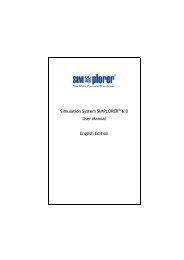Practical SCADA for Industry David Bailey - FER-a
Practical SCADA for Industry David Bailey - FER-a
Practical SCADA for Industry David Bailey - FER-a
Create successful ePaper yourself
Turn your PDF publications into a flip-book with our unique Google optimized e-Paper software.
2.3.2.2 Amplifier<br />
<strong>SCADA</strong> systems, hardware and firmware 21<br />
• Switching time<br />
A similar parameter to settling time, it specifies how long the multiplexer<br />
output takes to settle to the input voltage when the multiplexer is switched<br />
from one channel to another.<br />
• Throughput rate<br />
This relates to the highest rate at which the multiplexer can switch from<br />
channel to channel; it is limited by the settling time or the switching time,<br />
whichever is longer.<br />
• Transfer accuracy<br />
Expresses the input-to-output error as a percentage of the input.<br />
Where low-level voltages need to be digitized, they must be amplified to match the input<br />
range of the board’s A/D converter. If a low-level signal is fed directly into a board<br />
without amplification, a loss of precision will be the result. Some boards provide onboard<br />
amplification (or gain), while those with a PGA make it possible to select from<br />
software, different gains <strong>for</strong> different channels, <strong>for</strong> a series of conversions.<br />
The ideal differential input amplifier only responds to the voltage difference between<br />
its two input terminals regardless of what the voltage common to both terminals is doing.<br />
Un<strong>for</strong>tunately, common mode voltages do produce error outputs in real-world amplifiers.<br />
An important characteristic is the common mode rejection ratio, CMRR, which is<br />
calculated as follows.<br />
CMRR = 20log (Vcm / Vdiff) [dB]<br />
where:<br />
Vcm is the voltage common to both inputs<br />
Vdiff is the output (error) voltage when Vcm is applied to both inputs<br />
An ideal value <strong>for</strong> CMRR would be 80 dB or greater.<br />
Drift is another important amplifier specification; it depends on time and temperature.<br />
If an amplifier is calibrated to give zero output <strong>for</strong> zero input at a particular temperature,<br />
the output (still at zero input) will change over time and if the temperature changes.<br />
Time drift and temperature drifts are usually measured in PPM/unit time and PPM/°C,<br />
respectively. For a 12-bit board, 1 LSB is 1 count in 4096 or 244 PPM. Over an operating<br />
range of 0°C to 50°C, a 1 LSB drift is thus:<br />
244 PPM/50°C = 4.88 PPM/°C<br />
In choosing a component, you need to ensure that the board’s time and temperature<br />
drift specifications over the entire operating temperature range are compatible with the<br />
precision you require and don’t <strong>for</strong>get that it can get quite warm inside the RTUs<br />
enclosure.<br />
2.3.2.3 Sample-and-hold circuit<br />
Most A/D converters require a fixed time during which the input signal remains constant<br />
(the aperture time) in order to per<strong>for</strong>m an A/D conversion. This is a requirement of the<br />
conversion algorithm used by the A/D converter. If the input were to change during this<br />
time, the A/D would return an inaccurate reading. There<strong>for</strong>e, a sample-and-hold device is<br />
used on the input to the A/D converter. It samples the output signal from the multiplexer<br />
or gain amplifier very quickly and holds it constant <strong>for</strong> the A/Ds aperture time.
















